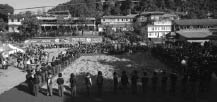 For the first time in Dharamsala, Tibetans who have not seen their homeland in many years have recently been given the opportunity to touch the soil of their country again. Members of the younger generation, many of whom have never set foot in Tibet themselves, can now keep with them a piece of the land their mothers and fathers have had to leave behind.
For the first time in Dharamsala, Tibetans who have not seen their homeland in many years have recently been given the opportunity to touch the soil of their country again. Members of the younger generation, many of whom have never set foot in Tibet themselves, can now keep with them a piece of the land their mothers and fathers have had to leave behind.
Artist Tenzin Rigdal’s installation, entitled “Our Land, Our People” opened on October 26th at the TCV School not far from McLeod Ganj. His exhibit consisted of 20,000 kg of soil which he brought undercover from an undisclosed location in Tibet. Laid on a stage in the courtyard at TCV, the soil was crowned by the banned Tibetan flag waving over a portraitof the Dalai Lama placed in the center of the installation. The more than 1,000 people who attended the opening event were invited to touch the soil, walk over it, and otherwise remind themselves of the feel of their homeland.
The piece was inspired by his father’s experience, said the New York-based Rigdal. A graduate of TCV himself, Rigdal was raised by his family abroad, and his father died in exile before fulfilling his last wish of returning to Tibet. His story is a very familiar one here in Dharamsala.
“Walking on Tibetan soil, I felt as if I was returning home to my native land after 51 years,” said Phuntsog Namgyal, 57, who attended the opening ceremony. “I was born in Tibet. Since my escape in 1959 I have not had the opportunity to go back. I felt the same emotion in my heart as if I was back in Tibet.”
As the opening progressed, the atmosphere became increasingly emotional, with many breaking down in tears or full prostrations when they laid eyes on the soil. Many TCV students and others in attendance were touching a piece of Tibet for the first time in their lives, and promises to study hard and work for the Tibetan cause spread among the crowds of young people.
Tibetan Prime Minister Lobsang Sangay spoke precisely to the emotions triggered by the presence of this installation in all members of the Tibetan community. “It has been the dream of many Tibetans to return to Tibet and set foot on Tibet’s soil. Many have passed away with that wish unfulfilled. Today I am stepping on this soil as a gesture of our struggle to reunite with our brothers and sisters in Tibet.”
A tray of the soil was taken to the Dalai Lama, who blessed it and traced the word “Bodh,” the Tibetan name for Tibet, at its center. As community members were invited to interact with the exhibit, a flute player from the Tibetan Institute for the Performing Arts performed a rendition of Dentsig Monlam, or “Prayer of Truth,” written by His Holiness. Younger students at TCV performed the song “Let’s Return to Tibet” and monks from the Kirti Monastery in Dharamsala held a prayer vigil for those who have died in the name of Tibet in recent months.
Since it’s opening, more than 6,000 Tibetans have visited the exhibit. It remained intact for three days, after which Tenzin Rigdol invited members of the community to bring containers of the soil back with them to their homes. Now, for the first time in more than 50 years, a veritable piece of Tibet can be found all throughout Dharamsala, living in the hearts and now literally in the homes of the Tibetan community in exile.




 Print
Print Email
Email